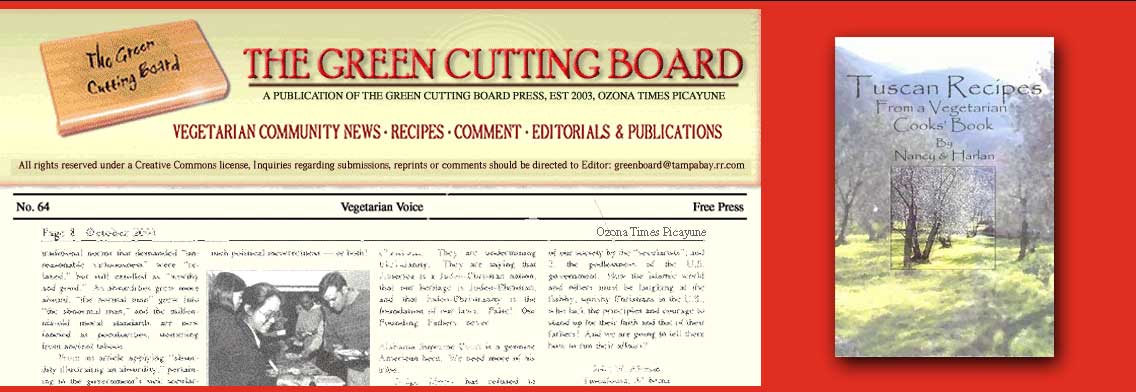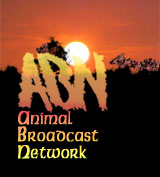Wednesday, June 30, 2004
Beggin Your Vegan
The Green Cutting Board would like to correct an error from our publication dated 6.20.04 "No Name Wraps", which we inadvertently labeled vegan. Our friend Ryan who writes the Veg Blog kindly advised us that "Morningstar Farms" bacon strips are not vegan, they contain egg white. We apologize for any unintended misrepresentation and have corrected the recipe.
You can still keep the recipe vegan if you substitute this Vegan Bacon for the Morningstar Farm soy bacon.
Morningstar Farms produces an outstanding product and theirs is not the fault, they clearly label their ingredients, just remember to read labels as you shop.
Now, because the news is slow today, as a follow-up to our recent series on Crocs this great story from my friend Ken, also my brother-n-law but who's name dropping.

Ken and Carol moved to Florida 2 years ago from Maine and now, as is always the case, relatives follow; case in point their son and his family.
The young man immediately got a job working outdoors with a firm laying underground pipe for the county. Now, this is a tough job for anyone let alone a man from up nor'east, not use to Florida flora and fauna: 100 degree temps, higher humidity than is humanely possible, up to your nethers every day in muddy water and god knows what else. Tan not withstanding came the day when his "buds" on the job informed him that,"come morning he was up to his neck in a croc pond (we have lots of those in Florida) to channel a line. The company was going to post a "shotgun" and well, best luck, have at it son."
Now, Ken and Carol had raised their family in Maine amid bear, back woods, poison ivy and mosquitoes which rival 727s and they developed among other survival skills a good aptitude for herbal remedies. Knowing this the son asked his father what precautions might he apply to ward off the croc menace. Ken immediately replied that he should place several cloves of fresh garlic in his pants pockets.
Satisfied and thus equiped the young man reported to work next morning and much to the glee of his co-workers announced that his father had devised a remedy to thwart any gator threat, "garlic." Well the day went, as expected, without incident and later that evening when son asked father why the garlic was a defense against croc attacks dad replied calmly, "what defense, the garlic just makes your leg taste better."
You can still keep the recipe vegan if you substitute this Vegan Bacon for the Morningstar Farm soy bacon.
Morningstar Farms produces an outstanding product and theirs is not the fault, they clearly label their ingredients, just remember to read labels as you shop.
Now, because the news is slow today, as a follow-up to our recent series on Crocs this great story from my friend Ken, also my brother-n-law but who's name dropping.

Ken and Carol moved to Florida 2 years ago from Maine and now, as is always the case, relatives follow; case in point their son and his family.
The young man immediately got a job working outdoors with a firm laying underground pipe for the county. Now, this is a tough job for anyone let alone a man from up nor'east, not use to Florida flora and fauna: 100 degree temps, higher humidity than is humanely possible, up to your nethers every day in muddy water and god knows what else. Tan not withstanding came the day when his "buds" on the job informed him that,"come morning he was up to his neck in a croc pond (we have lots of those in Florida) to channel a line. The company was going to post a "shotgun" and well, best luck, have at it son."
Now, Ken and Carol had raised their family in Maine amid bear, back woods, poison ivy and mosquitoes which rival 727s and they developed among other survival skills a good aptitude for herbal remedies. Knowing this the son asked his father what precautions might he apply to ward off the croc menace. Ken immediately replied that he should place several cloves of fresh garlic in his pants pockets.
Satisfied and thus equiped the young man reported to work next morning and much to the glee of his co-workers announced that his father had devised a remedy to thwart any gator threat, "garlic." Well the day went, as expected, without incident and later that evening when son asked father why the garlic was a defense against croc attacks dad replied calmly, "what defense, the garlic just makes your leg taste better."
|
|
|
|
|
Tuesday, June 29, 2004
Famous Secret recipes
T.G.I.Friday's Broccoli Cheese Soup
We veganized this original recipe and republished it with the permission of Top Secret Recipes. Find your favorite "secret recipe" and create your own vegan original - and let us in on the secret.
This is a great veganized version of TGIF's savory Broccoli and Cheese Soup.
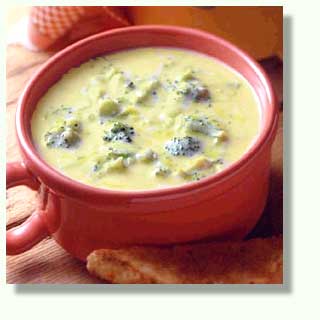 ingredients
ingredients
4 Cups vegetable broth
1 Cup water
1 Cup soy creamer
4 slices of soy cheddar singles
1/2 cup all-purpose flour
1/2 tsp dried minced onion
1/4 tsp ground black pepper
4 Cups fresh broccoli florets
Garnish
1/2 Cup shredded soy cheddar cheese
2 tsp minced fresh parsley
Preparation
Combine vegetable broth, water, soy creamer, sliced cheddar, flour, onion and pepper in a large sauce pan. Whisk to combine all the ingredients and break up any flour lumps and place on a medium high flame. Heat to a boil and reduce the flame to simmer.
Add the broccoli and continue to simmer fro 15-20 minutes or until broccoli is tender, not soft.
For each serving spoon one Cup of soup into a bowl and garnish with a Tbls of shredded cheddar and a pinch of parsley.
serves 6
vegan
We veganized this original recipe and republished it with the permission of Top Secret Recipes. Find your favorite "secret recipe" and create your own vegan original - and let us in on the secret.
This is a great veganized version of TGIF's savory Broccoli and Cheese Soup.
 ingredients
ingredients
4 Cups vegetable broth
1 Cup water
1 Cup soy creamer
4 slices of soy cheddar singles
1/2 cup all-purpose flour
1/2 tsp dried minced onion
1/4 tsp ground black pepper
4 Cups fresh broccoli florets
Garnish
1/2 Cup shredded soy cheddar cheese
2 tsp minced fresh parsley
Preparation
Combine vegetable broth, water, soy creamer, sliced cheddar, flour, onion and pepper in a large sauce pan. Whisk to combine all the ingredients and break up any flour lumps and place on a medium high flame. Heat to a boil and reduce the flame to simmer.
Add the broccoli and continue to simmer fro 15-20 minutes or until broccoli is tender, not soft.
For each serving spoon one Cup of soup into a bowl and garnish with a Tbls of shredded cheddar and a pinch of parsley.
serves 6
vegan
|
|
|
|
|
Thursday, June 24, 2004
Nero-ly Missing a Point of History
Nero, Emperor of Rome circa 68 A.D., is said to have favored the leek for its voice enhancing therapeutic qualities. Even if you don't perform for your fellow citizens, you'll love
Nero's Leek Soup
excerpt from: A Vegetarian Cooks' Book, The Green Cutting Board, 2004
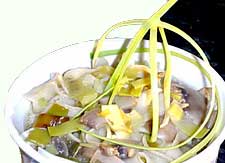 Ingredients
Ingredients
1 leek cut in half and cleaned (as leeks grow they pick up a lot of soil)
1/2 lb button mushrooms, cleaned and sliced
2 tsp olive oil
2 tsp vegetable oil
3 cups water
1/3 Cup dry white wine
1 cup eggless egg noodles ("eggless" varieties are clearly marked on the package)
sea salt & white pepper to taste
2 Tbls soy Parmesan cheese
Preparation
Cut the leeks into 1/2 " pieces. Slice the mushrooms.
Heat the olive and vegetable oil in a soup pot, sauté the leeks on high until they start to brown. Reduce heat by half and add the mushrooms. Cook covered until the mushrooms go limp, add the wine and cook uncovered until the alcohol is cooked off. Add the water and noodles, cover and cook the noodles aldente.
Season with salt and pepper. Garnish with slivers of leek and serve with grated Parmesan.
vegan
serves 2
excerpt from: A Vegetarian Cooks' Book, The Green Cutting Board, 2004
 Ingredients
Ingredients
1 leek cut in half and cleaned (as leeks grow they pick up a lot of soil)
1/2 lb button mushrooms, cleaned and sliced
2 tsp olive oil
2 tsp vegetable oil
3 cups water
1/3 Cup dry white wine
1 cup eggless egg noodles ("eggless" varieties are clearly marked on the package)
sea salt & white pepper to taste
2 Tbls soy Parmesan cheese
Preparation
Cut the leeks into 1/2 " pieces. Slice the mushrooms.
Heat the olive and vegetable oil in a soup pot, sauté the leeks on high until they start to brown. Reduce heat by half and add the mushrooms. Cook covered until the mushrooms go limp, add the wine and cook uncovered until the alcohol is cooked off. Add the water and noodles, cover and cook the noodles aldente.
Season with salt and pepper. Garnish with slivers of leek and serve with grated Parmesan.
vegan
serves 2
|
|
|
|
|
Sunday, June 20, 2004
No Name Wraps...OK, Name
excerpt from A Vegetarian Cooks' Book, The Green Cutting Board, 2004

We don't often call for brand name ingredients, but occasionally...well, just try these. OK.
Ingredients
1/2 tin "Pillsbury" original crescent rolls (original-no lard)
4 slices "Morningstar Farms" soy bacon strips
2 "Litelife" soy dogs
mustard
Preparation
Using 2 pair of pre-cut crescent roll wedges laid end-to-end, put 2 slices of soy bacon along the middle at an angle. Place a soy dog at one edge and roll up into the dough. Repeat with the remaining ingredients. Coat each roll with a little mustard.
Bake at 350°F uncovered for about 30 minutes or until golden brown.
Serve with any great side you prefer, come to think of it, just double the dogs now and save yourself the trouble.
serves 2
ovo vegetarian

We don't often call for brand name ingredients, but occasionally...well, just try these. OK.
Ingredients
1/2 tin "Pillsbury" original crescent rolls (original-no lard)
4 slices "Morningstar Farms" soy bacon strips
2 "Litelife" soy dogs
mustard
Preparation
Using 2 pair of pre-cut crescent roll wedges laid end-to-end, put 2 slices of soy bacon along the middle at an angle. Place a soy dog at one edge and roll up into the dough. Repeat with the remaining ingredients. Coat each roll with a little mustard.
Bake at 350°F uncovered for about 30 minutes or until golden brown.
Serve with any great side you prefer, come to think of it, just double the dogs now and save yourself the trouble.
serves 2
ovo vegetarian
|
|
|
|
|
Saturday, June 19, 2004
American Crocodile, Survival in the Balance
This is the third in our series examining the past and problematic future of the American Crocodile.
At the campus of the University of Florida, Gainesville the Crocodile Specialist Group works to provide evidence that this once robust Florida native is now sufficiently recovered from near extinction to be considered a renewable resource. Crocodylus acutus, or "American Crocodile" seen here in a family portrait along side its much larger prehistoric ancestor "Super Croc" has become the object of interest for industry research centers planning a not so pleasant future for our Florida croc.
an excerpt from our story Super Croc vs The U of Florida, a Fighting Ground.
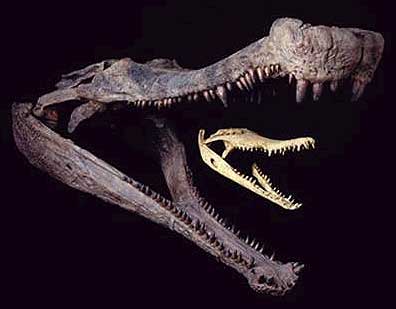 The Estuarine Crocodile or "Saltwater Crocodile" native to Australia is the world's largest living reptile typically growing up to 19 ½' in length and weighing as much as 2400 lbs, although larger individual sightings have been recorded. Despite their astonishing size the modern croc is small compared to its prehistoric ancestor Sarcosuchus imperatoro or "flesh crocodile emperor" which was a whopping 40' long and managed very nicely, thank you, during the early Cretaceous, 110 million years ago. The size of a London tourist bus this prehistoric animal lived at the top of his food chain and nothing was safe in its world.
The Estuarine Crocodile or "Saltwater Crocodile" native to Australia is the world's largest living reptile typically growing up to 19 ½' in length and weighing as much as 2400 lbs, although larger individual sightings have been recorded. Despite their astonishing size the modern croc is small compared to its prehistoric ancestor Sarcosuchus imperatoro or "flesh crocodile emperor" which was a whopping 40' long and managed very nicely, thank you, during the early Cretaceous, 110 million years ago. The size of a London tourist bus this prehistoric animal lived at the top of his food chain and nothing was safe in its world.
Read the entire story "Super Croc" on the Animal Broadcast Network.
At the campus of the University of Florida, Gainesville the Crocodile Specialist Group works to provide evidence that this once robust Florida native is now sufficiently recovered from near extinction to be considered a renewable resource. Crocodylus acutus, or "American Crocodile" seen here in a family portrait along side its much larger prehistoric ancestor "Super Croc" has become the object of interest for industry research centers planning a not so pleasant future for our Florida croc.
an excerpt from our story Super Croc vs The U of Florida, a Fighting Ground.
 The Estuarine Crocodile or "Saltwater Crocodile" native to Australia is the world's largest living reptile typically growing up to 19 ½' in length and weighing as much as 2400 lbs, although larger individual sightings have been recorded. Despite their astonishing size the modern croc is small compared to its prehistoric ancestor Sarcosuchus imperatoro or "flesh crocodile emperor" which was a whopping 40' long and managed very nicely, thank you, during the early Cretaceous, 110 million years ago. The size of a London tourist bus this prehistoric animal lived at the top of his food chain and nothing was safe in its world.
The Estuarine Crocodile or "Saltwater Crocodile" native to Australia is the world's largest living reptile typically growing up to 19 ½' in length and weighing as much as 2400 lbs, although larger individual sightings have been recorded. Despite their astonishing size the modern croc is small compared to its prehistoric ancestor Sarcosuchus imperatoro or "flesh crocodile emperor" which was a whopping 40' long and managed very nicely, thank you, during the early Cretaceous, 110 million years ago. The size of a London tourist bus this prehistoric animal lived at the top of his food chain and nothing was safe in its world.
Read the entire story "Super Croc" on the Animal Broadcast Network.
|
|
|
|
|
Saturday, June 12, 2004
It's a Croc
The question is, why protect a creature, why protect any creature; the answer may come to you as you read this.

It was announced earlier this year that the U.S. Fish and Wildlife Service had taken under advisement a recommendation to down list the American Crocodile from endangered to protected which sounds for all intent and purpose a good thing, a success; a species pulled back from the brink of oblivion, We set about to understand how this was possible. This is our report on Saving Crocodilian.
Crocodiles along with alligators, caimans and gavials make up the order Crocodilian descended through 300 million years of evolution from the great reptiles to this point in time, in this place, they have come to be regarded in their new role, a new existence unfamiliar to a species of predators descended from the Thunder Lizards; as captive, managed, bred, farmed.
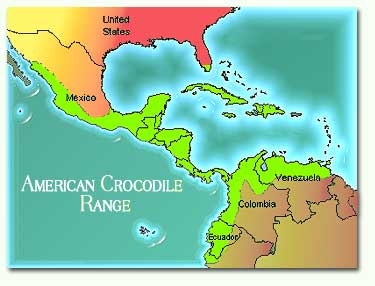
The American Crocodile, Crocodylus acutus inhabits a range (lime green on the map) that includes coastal South and Central America, Mexico, Cuba and southern most Florida. No one knows for sure how many individuals exist in the wild, estimates can be made by counting nests and using statistical tables to calculate brood survival rates and predation, but these are only estimates.
As we reported last week in the first in this series of articles on the return of the American Crocodile 300 Million Years and Counting estimates by the U.S. Fish and Wildlife Service indicate that in south Florida numbers have risen steadily from a mere 200 to approximately 1000 in the 20 years that the service has listed them as endangered. Consideration is being given to down listing the species from "endangered" to "threatened" by USFWS.
If you view the U.S. Fish and Wildlife Service site American Crocodile page you'll find a status report that lists, among other contributors, a group called Crocodile Specialist Group or CSG. The CSG is headquartered at the Florida Museum of Natural History, Gainesville, Florida, USA. Funded by membership from around the world the CSG is a private coalition of individuals and groups who maintain an active interest in the worlds population of reptilian species, particularly crocodiles, alligators, caimans and gavials, or the so called "commercial" breeds whose value can be calculated on the international market trade in their meat and hides. We contacted the office of CSG Executive, Dr. James Perran Ross, at the Florida Museum of Natural History, they did not return our request for a comment. The CSG is however, by their own account, instrumental in the effort to study the animal and recommend strategies for stabilizing the population.
The Crocodile Specialty Group is a member of the World Conservation Union, which formed in 1948 to focus government agencies, private interest groups and NGOs ia a worldwide effort to conserve the integrity and diversity of nature and ensure that any use of natural resources is equitable and ecologically sustainable. The IUCN has consistently held that the worlds natural resource: plants, animals, the natural environment and its human population can exist in a mutually adaptive and supportive partnership through studied, judicious management of those same resources. Now that may be read in many interpretations, the least acceptable of which should be; "a number of crocodilian species are exploited for their valuable skins, a natural commodity that earns over $200 million US annually in international sales. The high fashion leather goods made from the skins earn ten times that amount in retail sales." This is not what is meant by sustainable resource management put to "equitable and ecological" use; this is a $2 Billion annual return on a 25 year investment by the fashion industry, retailers, and farm industry representatives who comprise and finance the Crocodile Specialist Group. A visit to just one site, Alligator.com, provides a clear, if disturbing representation of the economic potential of the proposed trade in Crocodilian lives.
Crocodilian farming is widespread in industrialized countries like Columbia, the US (Louisiana, Florida) and Australia where the last International Conference of the CSG was held this past May 24-29, 2004. The key to promoting industrial farming of the American Crocodile lays in down listing this animal from endangered to threatened; when the population is stable annual controlled harvesting followed by captive farm bred populations is enabled and the circle is complete providing more economic incentive to already highly industrialized segments of the population while entirely bypassing third world agrarian populations.
There can be no doubt that the IUCN has done and continues to do important work as an international clearinghouse for environmentally responsible planning and development. Further more, it should be noted that, despite the difficulties of working across a global platform, government entities like the U.S. Fish & Wildlife Service do remarkably well brokering Federal/State issues for environmental protection and wildlife management particularly in the face of devastating budget reductions implemented by the Bush administration. The difficulty arises when private agent/lobbyists for special interest groups such as the "Crocodilian Specialties Group" insert their own member's interests above those of the environment and the process in order to exploit the system for future profit. One would suppose that the Japanese whaling industry or the IFTF could similarly take the reigns in whale and seal pup research and provide a plan to develop aquafarm plan rationales for industrial whale ranching and seal pup farms.
Finally, what are the alternatives to bioeconomic forces that propell the Crocodiles to salvation at the hand of commerce? We'll examine Crocodilians as nature's...
 "Masters of Self Preservation" in our next article.
"Masters of Self Preservation" in our next article.
"Days of Thunder" is a photo taken by Glenn Baker, of a male American Crocodile "bellowing" a courtship call that literally ripples the water. Glenn, who generously contributed this photo for our story, is a nature photographer who lives and works in Florida.

It was announced earlier this year that the U.S. Fish and Wildlife Service had taken under advisement a recommendation to down list the American Crocodile from endangered to protected which sounds for all intent and purpose a good thing, a success; a species pulled back from the brink of oblivion, We set about to understand how this was possible. This is our report on Saving Crocodilian.
Crocodiles along with alligators, caimans and gavials make up the order Crocodilian descended through 300 million years of evolution from the great reptiles to this point in time, in this place, they have come to be regarded in their new role, a new existence unfamiliar to a species of predators descended from the Thunder Lizards; as captive, managed, bred, farmed.

The American Crocodile, Crocodylus acutus inhabits a range (lime green on the map) that includes coastal South and Central America, Mexico, Cuba and southern most Florida. No one knows for sure how many individuals exist in the wild, estimates can be made by counting nests and using statistical tables to calculate brood survival rates and predation, but these are only estimates.
As we reported last week in the first in this series of articles on the return of the American Crocodile 300 Million Years and Counting estimates by the U.S. Fish and Wildlife Service indicate that in south Florida numbers have risen steadily from a mere 200 to approximately 1000 in the 20 years that the service has listed them as endangered. Consideration is being given to down listing the species from "endangered" to "threatened" by USFWS.
If you view the U.S. Fish and Wildlife Service site American Crocodile page you'll find a status report that lists, among other contributors, a group called Crocodile Specialist Group or CSG. The CSG is headquartered at the Florida Museum of Natural History, Gainesville, Florida, USA. Funded by membership from around the world the CSG is a private coalition of individuals and groups who maintain an active interest in the worlds population of reptilian species, particularly crocodiles, alligators, caimans and gavials, or the so called "commercial" breeds whose value can be calculated on the international market trade in their meat and hides. We contacted the office of CSG Executive, Dr. James Perran Ross, at the Florida Museum of Natural History, they did not return our request for a comment. The CSG is however, by their own account, instrumental in the effort to study the animal and recommend strategies for stabilizing the population.
The Crocodile Specialty Group is a member of the World Conservation Union, which formed in 1948 to focus government agencies, private interest groups and NGOs ia a worldwide effort to conserve the integrity and diversity of nature and ensure that any use of natural resources is equitable and ecologically sustainable. The IUCN has consistently held that the worlds natural resource: plants, animals, the natural environment and its human population can exist in a mutually adaptive and supportive partnership through studied, judicious management of those same resources. Now that may be read in many interpretations, the least acceptable of which should be; "a number of crocodilian species are exploited for their valuable skins, a natural commodity that earns over $200 million US annually in international sales. The high fashion leather goods made from the skins earn ten times that amount in retail sales." This is not what is meant by sustainable resource management put to "equitable and ecological" use; this is a $2 Billion annual return on a 25 year investment by the fashion industry, retailers, and farm industry representatives who comprise and finance the Crocodile Specialist Group. A visit to just one site, Alligator.com, provides a clear, if disturbing representation of the economic potential of the proposed trade in Crocodilian lives.
Crocodilian farming is widespread in industrialized countries like Columbia, the US (Louisiana, Florida) and Australia where the last International Conference of the CSG was held this past May 24-29, 2004. The key to promoting industrial farming of the American Crocodile lays in down listing this animal from endangered to threatened; when the population is stable annual controlled harvesting followed by captive farm bred populations is enabled and the circle is complete providing more economic incentive to already highly industrialized segments of the population while entirely bypassing third world agrarian populations.
There can be no doubt that the IUCN has done and continues to do important work as an international clearinghouse for environmentally responsible planning and development. Further more, it should be noted that, despite the difficulties of working across a global platform, government entities like the U.S. Fish & Wildlife Service do remarkably well brokering Federal/State issues for environmental protection and wildlife management particularly in the face of devastating budget reductions implemented by the Bush administration. The difficulty arises when private agent/lobbyists for special interest groups such as the "Crocodilian Specialties Group" insert their own member's interests above those of the environment and the process in order to exploit the system for future profit. One would suppose that the Japanese whaling industry or the IFTF could similarly take the reigns in whale and seal pup research and provide a plan to develop aquafarm plan rationales for industrial whale ranching and seal pup farms.
Finally, what are the alternatives to bioeconomic forces that propell the Crocodiles to salvation at the hand of commerce? We'll examine Crocodilians as nature's...
 "Masters of Self Preservation" in our next article.
"Masters of Self Preservation" in our next article.
"Days of Thunder" is a photo taken by Glenn Baker, of a male American Crocodile "bellowing" a courtship call that literally ripples the water. Glenn, who generously contributed this photo for our story, is a nature photographer who lives and works in Florida.
|
|
|
|
|
It's Impossible to McMess This Up
Every so often there is nothing like a fried egg sandwich. Here's one guaranteed to please even the most egg-centric among us.
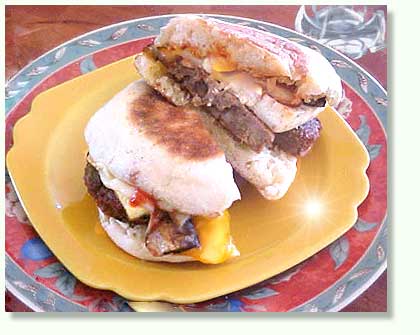
Eggless Sausage McMuffin
excerpt from: A Vegetarian Cooks' Book, The Green Cutting Board 2004
Ingredients
2 English muffins buttered and heated through, not toasted
2 soy breakfast sausage patties
4 medium size mushrooms sliced
2 1/4" slices of extra firm tofu
Monterey jack soy cheese
cheddar soy cheese
soy spread
ketchup
salt and pepper to taste
Preparation
The key to this breakfast sandwich is flavoring the tofu. Begin by heating a small fry pan coated with soy spread. Brown the sausage patties on both sides, about 2 minutes per side, and reserve. Add more spread to the pan and sauté the sliced mushrooms until softened.
In the same pan, without removing the mushrooms add 2 slices of tofu and continue to sauté until slightly browned. The pan mushrooms, soy spread and sausage bits infuse the tofu with flavor.
Place a slice of Monterey jack on each piece of tofu and top with a smaller piece of cheddar (the idea is to look like an egg yolk). Cover the pan and turn off the heat to let the cheese melt slightly - about 2 minutes.
Assemble the sandwich by placing a sausage on the pre-heated muffin; top with cooked tofu and cheese slices and 1/2 the sautéed mushrooms. Place the open-faced sandwich in a toaster oven set at 350º for 2-3 minutes. Remove the sandwich, salt and pepper to taste, add some ketchup and top with the remaining muffin halves.
serves 2
vegan

excerpt from: A Vegetarian Cooks' Book, The Green Cutting Board 2004
Ingredients
2 English muffins buttered and heated through, not toasted
2 soy breakfast sausage patties
4 medium size mushrooms sliced
2 1/4" slices of extra firm tofu
Monterey jack soy cheese
cheddar soy cheese
soy spread
ketchup
salt and pepper to taste
Preparation
The key to this breakfast sandwich is flavoring the tofu. Begin by heating a small fry pan coated with soy spread. Brown the sausage patties on both sides, about 2 minutes per side, and reserve. Add more spread to the pan and sauté the sliced mushrooms until softened.
In the same pan, without removing the mushrooms add 2 slices of tofu and continue to sauté until slightly browned. The pan mushrooms, soy spread and sausage bits infuse the tofu with flavor.
Place a slice of Monterey jack on each piece of tofu and top with a smaller piece of cheddar (the idea is to look like an egg yolk). Cover the pan and turn off the heat to let the cheese melt slightly - about 2 minutes.
Assemble the sandwich by placing a sausage on the pre-heated muffin; top with cooked tofu and cheese slices and 1/2 the sautéed mushrooms. Place the open-faced sandwich in a toaster oven set at 350º for 2-3 minutes. Remove the sandwich, salt and pepper to taste, add some ketchup and top with the remaining muffin halves.
serves 2
vegan
|
|
|
|
|
Wednesday, June 09, 2004
Spice Tells
Spiceblog from Australia digs into his particular culinaria and sends us this recipe - vegetarian if you use oil instead of ghee. Anthony writes this "talk about"...
Kabli Channa
Curried Chick Peas

Margaret Fulton is to be thanked for this recipe. She is a kind of Grand Dame of Australian cooking and, in a country that took erm' England as its culinary inspiration, something of a groundbreaker. Her books of the seventies not just cemented burnt orange as my favourite colour but brought a good sampling of the world's food into the Australian kitchen. By the time I bought her slim cookbook "Indian Cooking" 15 years ago, she had dragged much of India here. It's a bit on the dry side so add a saucier accompaniment but you don't have to actually eat it, just stick your head in the pot while frying the spices.
INGREDIENTS
250gm Chick Peas soaked overnight
3 cups lightly salted water
2tbs of oil (or ghee)
1 chopped onion
4 cloves
I inch of cinnamon
2 crushed garlic cloves
1 inch of chopped ginger
2 green chilies - chopped finely
2 tsp ground coriander (cilantro)
1 chopped tomato
1 tsp garam masala
chopped coriander for garnish
Simmer the chick peas until tender. Drain but reserve the water for later.
Heat the oil and then add the chopped onion and fry until coloured. Add the cloves and the cinnamon stick and fry for a few seconds before adding the garlic cloves; tginger; chillies; and the ground coriander and fry for 5 minutes. Add the chopped tomato and cook until most of the liquid's gone.
Add the chick peas and cook gently for 5 minutes. Then add the reserved water and simmer for 20-25 minutes. Add the garam masala and stir well. Top with some chopped coriander.
Serves 4
Curried Chick Peas

Margaret Fulton is to be thanked for this recipe. She is a kind of Grand Dame of Australian cooking and, in a country that took erm' England as its culinary inspiration, something of a groundbreaker. Her books of the seventies not just cemented burnt orange as my favourite colour but brought a good sampling of the world's food into the Australian kitchen. By the time I bought her slim cookbook "Indian Cooking" 15 years ago, she had dragged much of India here. It's a bit on the dry side so add a saucier accompaniment but you don't have to actually eat it, just stick your head in the pot while frying the spices.
INGREDIENTS
250gm Chick Peas soaked overnight
3 cups lightly salted water
2tbs of oil (or ghee)
1 chopped onion
4 cloves
I inch of cinnamon
2 crushed garlic cloves
1 inch of chopped ginger
2 green chilies - chopped finely
2 tsp ground coriander (cilantro)
1 chopped tomato
1 tsp garam masala
chopped coriander for garnish
Simmer the chick peas until tender. Drain but reserve the water for later.
Heat the oil and then add the chopped onion and fry until coloured. Add the cloves and the cinnamon stick and fry for a few seconds before adding the garlic cloves; tginger; chillies; and the ground coriander and fry for 5 minutes. Add the chopped tomato and cook until most of the liquid's gone.
Add the chick peas and cook gently for 5 minutes. Then add the reserved water and simmer for 20-25 minutes. Add the garam masala and stir well. Top with some chopped coriander.
Serves 4
|
|
|
|
|
Monday, June 07, 2004
Planet City in a Bowl... An Eco Town Takes Root
By the year 2007, for the first time in history, humanity will be primarily an urban species — homo sapiens urbanis.

Over 75 per cent of all North Americans and Europeans already live in cities, and in a few years most Southern citizens will have joined them. Each week another million people either move to or are born into a city. By 2015, there will be at least 23 “mega-cities” in the developing world, each with more than 10 million people.
Can the planet carry the weight of this urban sprawl? The world's cities take up just two per cent of the Earth's surface, yet account for 78 per cent of the carbon emissions from human activities — the biggest source of the greenhouse gases that contribute to global warming, says the Worldwatch Institute, a Washington, DC-based research institute.
Many cities also fail to provide decent living conditions for all their residents. Some 600 million to one billion urbanites lack adequate shelter and live without easy access to clean water, toilets or electricity.
The Ecological Footprint
Imagine if a giant glass bowl was inverted over top of a city like Montreal, Canada. Nothing but sunlight could get in. Obviously most of the people inside wouldn't survive long because the city needs food, air, places to put waste and ways to obtain other resources from outside the city limits to sustain itself.
So how much bigger would the glass bowl have to be in order for everyone in the city to survive at their present standard of living? In other words, how big is Montreal's Ecological Footprint?
William Rees at the University of British Columbia has calculated ecological footprints for a number of hot spots around the world and determined that the average North American citizen uses the natural resources from 7.7 hectares (19 acres) of land.
And so Montreal with a population of 3.5 million has a whopping footprint of 270,000 sq. km, about half the size of France, and considerably more than the 462 sq. km the city actually occupies. Similar sized cities in the US and Australia have even bigger, more unsustainable footprints.
Because material resource use is lower in the Developing World - India averages just 0.5 hectare per person - those cities have much smaller ecological impact.
The dilemma, however, is that for everyone to live at the same level of material wealth as North American city-dwellers, we'd need another three or four planets. Since good planets are hard to find, cities and towns have to better balance the demands of people with nature. They must leave smaller “ecological footprints” by using less water and generating less waste, boosting self-reliance in food and energy, and promoting sustainable transportation.
Perhaps the most unlikely place for such a green town to take root is in the brown dirt of a slum called Ivory Park in South Africa.
Ivory Park, home to 200,000 people living in shacks topped with corrugated tin roofs, lies within the town of Midrand on the outskirts of Johannesburg. It is also home to grinding poverty. As many as 50 per cent of the adults are unemployed. Children play on potholed streets, dodging streams of polluted water. A permanent cloud of hazy smoke from tin-drum coal fires used for cooking hangs heavy. Respiratory illnesses are common.
Emerging from the ruddy soil is hope — in the form of brightly coloured buildings that make up the Ivory Park EcoCity village. Here, poverty eradication and sustainable development meet in a fusion of African and Western ideas to improve life for people and the planet.
At the edge of town is a market where farmers from six co-ops sell their organic produce. Within the village, several types of environmentally friendly houses are being showcased. The community centre, used for workshops and training, is a good example of the ecological construction common in Ivory Park. The centre is a round building of clay and concrete, with used polystyrene blocks as insulation and doors salvaged from a condemned building. It has a soil roof, with grass growing on the top and sloping sides so that children can play on it. The temperature inside is always comfortable, no matter what the season, because soil has insulating properties, keeping the centre warm in winter and cool in summer.
“It's just like having air conditioning,” says Annie Sugrue, an EcoCity managing trustee.
The Ubuhle Bemvelo Eco-Construction Co-op is building 30 of the eco-houses. The 14 women working in the co-op use indigenous materials and environmental building techniques adapted to local conditions. For example, thick earthen walls absorb heat during the day and radiate it during the cool nights of winters.
The houses are purchased through a housing subsidy process, with preference given to those involved in the EcoCity. “We want people to live and work in the same place, as it cuts down on transport and pollution,” explains Sugrue.
The EcoCity was born as an experiment in alleviating poverty — and doing it without jeopardizing long-term ecological health. A non-governmental organization called Earthlife Africa first obtained a US$1.7-million grant from the Danish government in 1999. Since then, there has been funding from Canada, Switzerland and Sweden, and partnerships have been struck with the World Wildlife Fund and the United Nations Development Programme. The project is now “owned” by the Johannesburg city council, and local and foreign businesses have come to the table, as have different South African government agencies.
The project is both a showcase demonstration and a training centre, but above all it's home for its residents. Mundane but pressing facets of life must be tackled.
For instance, to cope with the endless smoke from cooking fires, an energy centre encourages people to buy cleaner liquid propane in canisters and alternative energy equipment such as solar cooking ovens. One vital development has been the so-called “smokeless umbhawula,” an innovative tin-drum coal cooker that uses far less fuel than normal, and radically reduces the amount of unhealthy smoke.
Trash is another major problem in South Africa, but a successful Ivory Park waste recycling co-operative has offered an option. Now employing more than 40 people, bottles, glass, paper, plastics and tin are brought by waste collectors to a buy-back centre, which then sorts the waste and sells it to recycling companies.
A recycling project of a different kind is housed in a big metal shipping container. The Shova Lula (easy pedal) cycle co-operative imports second-hand bikes and parts from England, Germany and Switzerland, then bicycle mechanics repair and sell the working wheels to community members.
Involving youth has been key to the accomplishments of Ivory Park. Youth work at the bicycle co-op, serve as EcoCity guides and conduct environmental education workshops in schools and the community. A new project will train one hundred youth in eco-building techniques using earth bricks and passive thermal designs. Others will learn organic landscaping and farming techniques, and how to build biogas digesters that convert food and animal wastes into a clean fuel for cooking.
“The focus of the project is on self reliance,” says Annie Sugrue. “South Africa has serious economic problems and at present cannot provide all the social services people need like electricity, clean water and sanitation. The poor feel they have little power to change things so they sit around and hope someone will come along and save them.”
“That's not going to happen.”
But community members do realize that a village needs to be sustainable and self-reliant — traditional African values. “The EcoCity concept has been very well received by local people,” Sugrue says. However, the project is still heavily dependent on outside support.
Despite this, Ivory Park's ecovillage is expanding. More homes are being built, and initiatives such as large-scale biofuel production are on the horizon. Just as important, tens of thousands of people have visited the village, particularly during the World Summit on Sustainable Development in 2002, held in Johannesburg.
And good ideas travel: ecovillages are growing in South Africa and elsewhere.
In Senegal, for instance, 12 villages are being transformed into greener communities. Governed through community-based decision-making, the hearts of these villages beat with organic agriculture, solar energy and micro-enterprise economic development.
Internationally, an informal collection called the Global Ecovillage Network encompasses hundreds of small communities in Europe, North America and Asia. Some of these started in the 1960s as communes, and all are pursuing the objective of creating a better quality of life while living lighter on the planet.
At the larger end of the scale, many cities are seeking a greener future as well. The International Council for Local Environmental Initiatives, with over 2,000 member municipalities, is active in helping cities become more sustainable.
One member, Melbourne, Australia, home to 3.4 million people, is on target to eliminate its contribution of greenhouse gases by 2020. With comprehensive energy reductions of 50 per cent, the use of renewable energy and the absorption of local emissions in widely sowed native vegetation, Melbourne will likely be the first industrial city to achieve zero-net emissions.
And who knows what on earth Ivory Park will have accomplished by then.
by Stephen Leahy
International Development and Environment Article Service
|
|
|
|
|
Wednesday, June 02, 2004
NJ Announces 64 Mile Route to Connect Greenway

The New Jersey Department of Transportation in partnership with the East Coast Greenway Alliance, the nonprofit organization developing a 2600-mile trail connecting cities of the eastern seaboard for non-motorized users, has unveiled the new trail route for the East Coast Greenway through northern New Jersey.
NJDOT’s study identified a 64-mile route through 5 counties and 22 municipalities connecting the existing Delaware and Raritan River Canal Towpath, the Middlesex Greenway and Jersey City’s Historic Harsimus Cove Railroad Embankment and onto the Hudson River Walkway which will provide access to New York City via multiple water ferries.
The recommended route accomplishes the ECGA’s goal that at least 80% of the Greenway be off-road, with safe on-road and sidewalk connections for walkers, runners and bikers.
According to Karen M. Votava, ECGA Executive Director, "The Newark-Jersey City area was the only major urban center along the east coast not on the ECG route. We’re pleased that NJDOT enabled us to find a feasible off-road route that will allow these cities to become destinations along the Greenway."
Local area attractions will benefit from the off-road access provided, including Rutgers and Princeton Universities, The Meadowlands State Wildlife Preserve, Newark Riverfront Stadium, Liberty State Park, The Statue of Liberty and Ellis Island.
"Trails are important for public health", says Karen Votava. "In this time of expanding waistlines, it is important that Americans have convenient and safe facilities for recreation and exercise. Trails fit the bill, whether you’re walking, cycling, skating, or even cross-country skiing. The East Coast Greenway, because it passes through so many urban centers, will be used by millions of Americans."
|
|
|
|
|
Charm City Powerhouse, an Olympian Sandwich
Before I had the good sense to become a vegetarian I would often eat lunch in a small health food store near Johns Hopkins Campus on Charles St - probably closed now.
The store was staffed with students in robes more health gurus than short order cooks who served a variety of great veg deli-like food, meditational tsatskes and a jolt of energy called the "Powerhouse."
While everything in the store was great, the Powerhouse stood out. Fresh, heavy with rich Fontina, aromatic ripe vegetables, sprouts that crunched and dressing that seemed to flow directly from the gods it was magnificent. I have not seen its like since.
Powerhouse Sandwich
excerpt from: A Vegetarian Cooks' Book, The Green Cutting Board, 2004
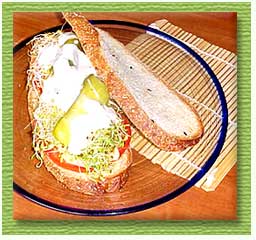
Ingredients
2 ¾" slices multigrain bread
4 oz soy Fontina or other soft cheese (¼" - ½" thick)
2 ¼" slices fresh tomato
fresh sprouts
hummus
sliced kosher dill pickle
2-3 Tbls soy ranch dressing
Preparation
Spread one slice of bread with hummus. Layer tomato slices, cheese and sprouts. Top with dressing and bread slice.
vegan
serves 1 god (2 mortals)
The store was staffed with students in robes more health gurus than short order cooks who served a variety of great veg deli-like food, meditational tsatskes and a jolt of energy called the "Powerhouse."
While everything in the store was great, the Powerhouse stood out. Fresh, heavy with rich Fontina, aromatic ripe vegetables, sprouts that crunched and dressing that seemed to flow directly from the gods it was magnificent. I have not seen its like since.

Ingredients
2 ¾" slices multigrain bread
4 oz soy Fontina or other soft cheese (¼" - ½" thick)
2 ¼" slices fresh tomato
fresh sprouts
hummus
sliced kosher dill pickle
2-3 Tbls soy ranch dressing
Preparation
Spread one slice of bread with hummus. Layer tomato slices, cheese and sprouts. Top with dressing and bread slice.
vegan
serves 1 god (2 mortals)
|
|
|
|
|
